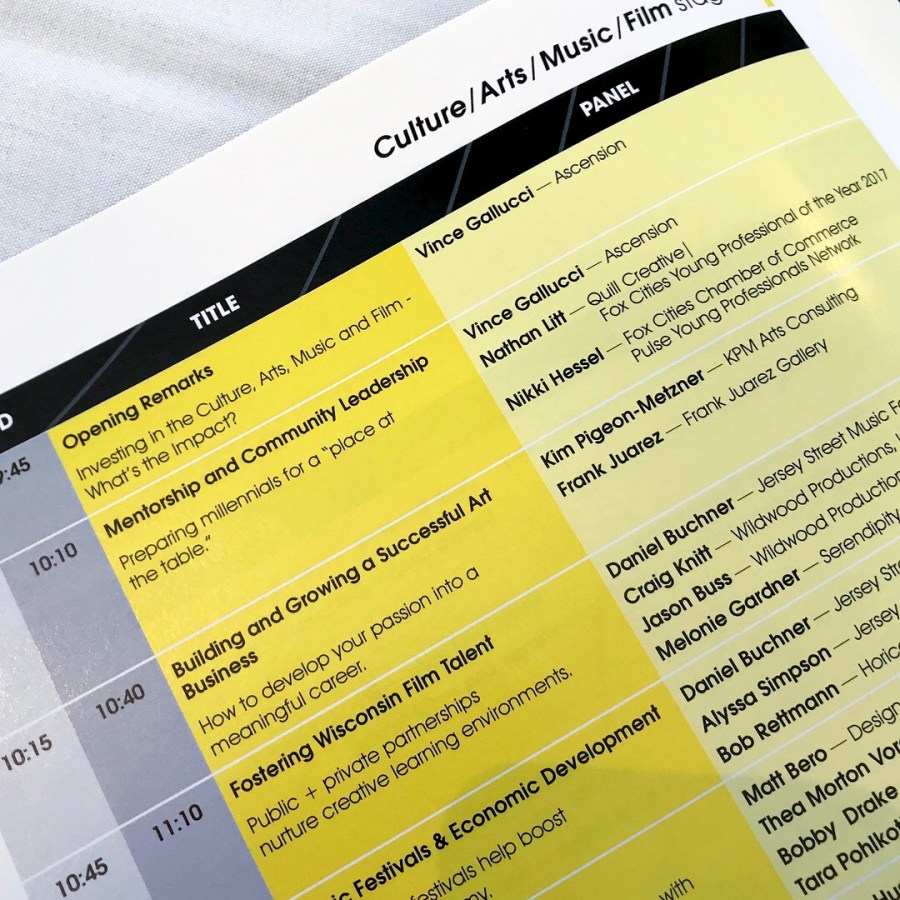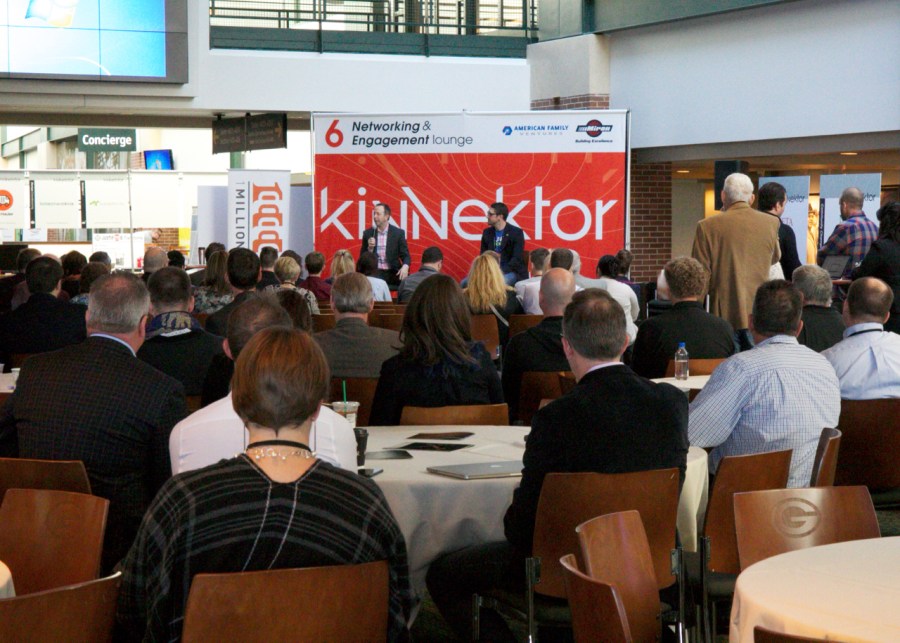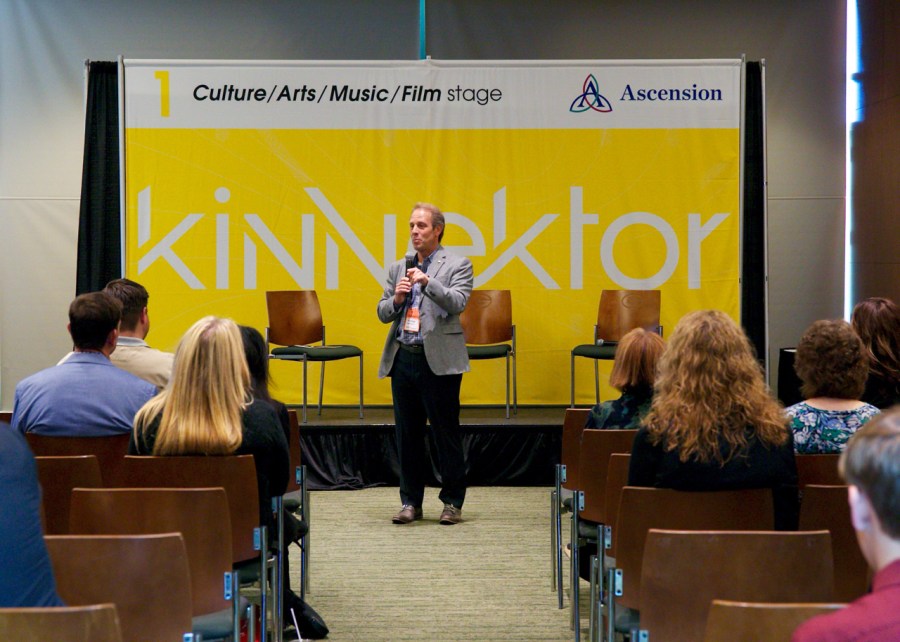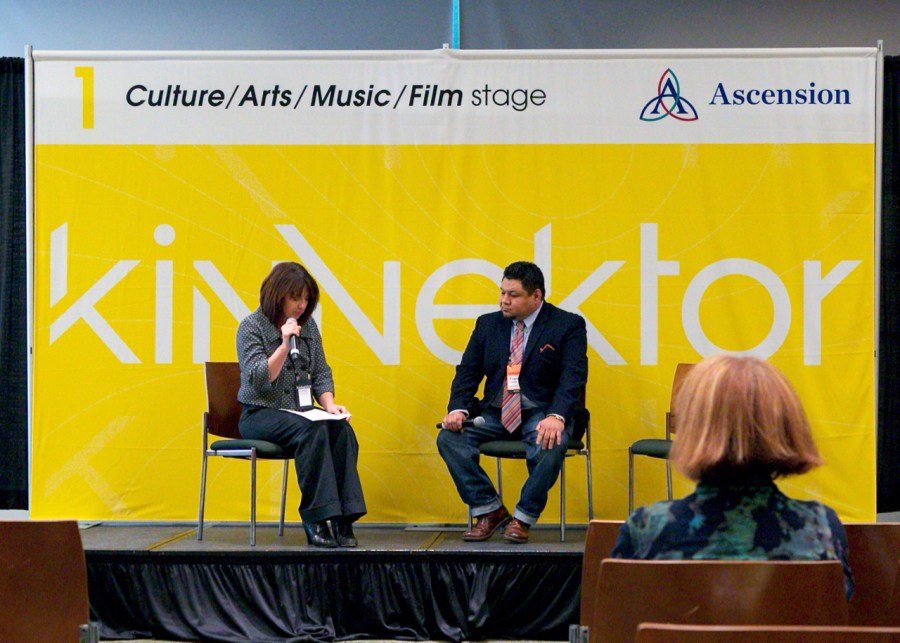
Today Kim and I took the stage at Kinnektor (formerly Launch Wisconsin) at Lambeau Field. Kim was the moderator for Building and Growing a Successful Art Business. Below is the transcript of our 25 minute discussion.
Kim Pigeon Metzner: Can you tell me a little bit of how and why you got into the gallery business?
Frank Juarez: I remember being curious about different facets of the art world back in 2005. I was already teaching and creating art, but I felt that I could learn so much more such as the business side of art, marketing, advocacy, and selling art. It made sense to me that figuring out how to get those type of experiences were a necessity.
KPM: What types of artists do you typically work with?
FJ: Through a variety of projects I oversee such as the 365 Artists 365 Days Project, Midwest Artist Studios, and Artdose Art Guide, I work with all types of artists. When it comes to my own gallery I work exclusively with 6 artists whose work focuses in the realm of Contemporary Art.
KPM: I know you have developed several artists workshops that teach artists business skills. Why do you feel it is important for artists to develop their business skills?
FJ: Artists need to learn how to market, promote, and engage others about the type of art they create. Making art is expensive and time consuming. Our time in the studio making art should be balanced by the business side of art. Developing necessary skills that will help bring revenue into the studio is a great way to invest in a sustainable practice.
KPM: We both know a lot of artists that are part time artists trying to make that decision as to whether they should become full time professional artists. How does an artist know if he/she is prepared to make that leap and become a career artists?
FJ: It starts with the artist’s vision of what their career may look like. Chances of being an overnight success is pretty slim. Therefore, artists need to be honest with what they want out of their studio practice. I remember being in college and I had a professor ask me where I would be in five years. The bigger question is where I would be in one year. This is a big difference, which can have an impact on what direction you need to take your career.
KPM: What do you think the myths are of being a career artist?
FJ: I think sometimes artists feel like they are waiting to be discovered or that their art will speak for itself. I never understood why artists do not want to talk about their work. Now, this is a generalization, but I do know several artists that do not like to. What better way to engage an audience than sharing a few things about their vision, process, and practice. Having a career in art is an investment.
KPM: We have been hearing about the shift of traditional commodity based economies to creative economies what do you think will make artists successful in the new economy?
FJ: First of all, artists need to define what success means to them and their world. Success is not defined solemnly by money. One of the things I like about this event is the idea of building community across the state and through various means of innovation, entrepreneurship, and networking. I think artists should adopt this philosophy and apply it to their own [art] communities and personal practice.
KPM: How do you think the Internet has changed the opportunities for artists?
FJ: Things today are way different. Everything is online and we are bombarded by images daily. We need to embrace the technology we have today at our fingertips and figure out how to maximize it to benefit our artistic and studio practice. Opportunities are out there. The only difference is being able to spot them. If you do not have an active online presence it can be difficult to find them.
KPM: Do you think Midwest artists find it difficult to be successful career artists compared to those living/working in California or New York?
FJ: The media plays a big role in defining a successful artist. When people think about successful artists chances are they are not thinking about Oskaloosa, IA; Ann Arbor, MI; Rushville, IL; Sheboygan, WI; to name a few. It is difficult to give everyone the spotlight, which is why we need to champion artists in our own communities. There are a lot of talented artists living and working in the Midwest. If things are difficult to be a successful career artist, then you are not looking hard enough.
KPM: What one suggestion would you give to artists considering a career as an artist.
FJ: One suggestion I would give artists is to follow the beat to your own drum. Sounds cliche, but makes total sense to me. Don’t worry too much about what others think about your work. If you feel proud of what you are doing, that is most important. Be true to you.
KPM: What other projects or events do you have lined up this year?
FJ: I will be presenting at the Wisconsin Art Education Association Conference in Fort Atkinson later this month. I will be presenting on A Meditation in Movement: Exploring Space and How to Start Your Own School’s Artist in Residency Program as well as co-presenting on the DIY Gallery: A Deeper Look Into the 365 Artists 365 Days Project. In November, I will be participating in the South East Wisconsin Resource Fair at the Wustum Museum of Art in Racine. In December, I will be a keynote speaker at the Illinois Art Education Association Conference. I will be speaking about how I balance my life as a gallery owner, art educator, and artist.
Gallery
About Frank Juarez

Frank Juarez is a gallery director, art educator, artist, published author, presenter, and arts advocate living and working in Sheboygan, Wisconsin. Organizing local and regional art exhibitions, community art events, facilitating presentations, and supporting artists through professional development workshops, use of social media and networking has placed him in the forefront of advancing and promoting local artists and attracting regional and national artists to interact, collaborate, network and exhibit in the Wisconsin.
Juarez is the art department chair at Sheboygan North High School. He is actively involved in local, regional, state, and national arts organization such as the Wisconsin Art Education Association, and the National Art Education Association. He has served as a board member in the following organizations: Milwaukee Artist Resource Network, Arts Wisconsin, and the Cedarburg Cultural Center. He is the founder/former director of the Sheboygan Visual Artists. In 2011, he has opened his first art gallery, the Frank Juarez Gallery in Sheboygan and has relocated to Milwaukee, Wisconsin. He has been presenting at local universities, colleges, galleries, and artist groups on the Business of Art | Art of Business. He is the founder of two projects focused on contemporary art and art education called The Midwest Artist Studios and the 365 Artists 365 Days Project. In 2015, he was recognized as the 2015 Wisconsin Art Education Association Teacher of the Year and in 2016, he was recognized at the 2016 National Art Education Association Wisconsin Art Educator of the Year. Recently, he has joined the faculty of the Vermont College of Fine Arts and SchoolArts Magazine as a contributing editor.
About Kim Pigeon-Metzner
 Kim Pigeon- Metzner is owner and operator of KPM Arts Consulting, LLC. Her passion for the arts include a wide variety of mediums and styles and started while attending the University of Wisconsin Green Bay. She has a degree in Communication and the Arts with a Business Minor.
Kim Pigeon- Metzner is owner and operator of KPM Arts Consulting, LLC. Her passion for the arts include a wide variety of mediums and styles and started while attending the University of Wisconsin Green Bay. She has a degree in Communication and the Arts with a Business Minor.
For ten years after graduating from college, she created custom three- dimensional exhibits for the trade show industry and for museums in Milwaukee, WI. This job included consulting with the client to determine their needs and the image they wanted to convey for their company, designing the exhibit, and working with project managers and a constructions crew to oversee the completion of the project. Some of her high end clients included SubZero, RayoVac, Potowatomi, Betty Brinn Museum, Vans Shoes, Milwaukee Institute of Art and Design, and the Milwaukee Convention Bureau; to name a few. The skills she acquired as a designer were to being able to listen and work with her clients to create a design and image that expressed the philosophy and ideals of each business and organization.
In 2005 she returned to her hometown of Green Bay, WI to help develop a brand new not-for-profit art gallery. She worked as the gallery Manager and Artist Resource director and built relationships with hundreds of local and regional artists helping them manage and expand their art career. Her job included curating many different art exhibits for the gallery including solo and group art exhibits, themed exhibits, and cultural exhibits. She also had the privilege to work with many community organizations including the Boys and Girls Club, John Dewey Academy, Aging Disability and Resource Center, University of Wi Green Bay, Northeast Wisconsin Artisan Center, Aspiro, and many other local art organizations.
As an arts consultant for KPM Arts Consulting LLC, Kim combines twenty plus years of experience in the arts as a designer and artist resource director. Her objective is to create the perfect space for businesses and organizations using original artwork to enhance a message or image. She works with a handful of established artists to create any custom piece of artwork including two dimensional artwork, murals, and sculptures and works with a vast library of existing artwork in order to achieve the perfect design. Her love for the arts has led her to volunteer her time serving on a public art committee and helping with various pop up art events in the area.









